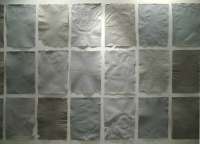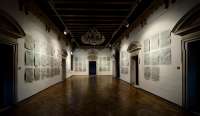TITLE “These things I do, and shall do, if I can, are no longer, or are not yet, or never were, or never will be, or if they were, if they are, if they will be, were not here, are not here, will not be here, but elsewhere”.
DESCRIPTION The whole archive of my failed and never realized projects had been recycled through a recycling process and the 65 sheets of paper obtained by this process had been hanged to the wall forming a grid.
I have gathered together all the drawings, photos, and projects I began working on and that I never realized, starting from 2002. I’ve ended up in doing a spontaneous archive of unrealized ideas, dreams, and objects. All these “things” share an attitude: a subjectivity that questions its own structure, its own daily art practice. They also share a procedure of time's scanning: silent witnesses of an inner archive of the everyday. Here, history serves me as a way of identifying displaced works as such so that they can no longer hurt me. My failures, my drops, becomes now the raw material by which this these sheets will be done, linked in random forms of continuous reciprocal causation. A regenerative process through which the negative becomes positive insofar as possibility.
This is not a way for me to represent my history, but to experience it by embody, embed, extended, review, refine and reformat it. To serve life one has to develop a proper relationship with history - at least his own history, to do this is to transform and incorporate into oneself what is past and foreign. Gazing through the residual nature of this big archive, I found myself thinking and watching at the same time cripple gestures, stuttering moments. From photography to drawings, from maps to labels, I am kept in a movement from form through disorder to the temporary peaceful existence of the informe.
How can the weight of the past signify productively in the present?
The various kinds of memory scaffolding which humans use, from knots, rhymes, codes, diagrams, slide-rule, and sketchpads to artificial memory techniques, photographs, books, rituals, and computers, have quite different properties and can shape the specific form and content of individual memory.
So what dose it means exactly to transform this attempts at something, this dead roads of my history in a new blank leaf? A big part of my work is about the issue of “crisis”. Each of my works is the result of an everyday practice of putting to the test the practice itself.
Those works are like fetishes from the past to me: take them and to use them as raw material instead of attempts is a way to let them go. “These things I do,...” is a project related to becoming and compounds two modes of perception: contemplative distance and tactile immediacy. The aim is to transform and reconstruct an hidden daily practice into a broader picture in which to read how the traces of past changes are actively doing something in the present. In a dialectic relationship of closeness and distance, to watch at these traces is present because I re-function the “utensils” of my artistic practice by exposing their disgregation.
Samuel Beckett, from which I refer in the title, ends up writing: “...if they are, if they will be, were not here, are not here, will not be here, but elsewhere. But I am here. So I am obliged to add this”.
But I am here. So I am obliged to add this
TITLE “These things I do, and shall do, if I can, are no longer, or are not yet, or never were, or never will be, or if they were, if they are, if they will be, were not here, are not here, will not be here, but elsewhere”.
DESCRIPTION The whole archive of my failed and never realized projects had been recycled through a recycling process and the 65 sheets of paper obtained by this process had been hanged to the wall forming a grid.
I have gathered together all the drawings, photos, and projects I began working on and that I never realized, starting from 2002. I’ve ended up in doing a spontaneous archive of unrealized ideas, dreams, and objects. All these “things” share an attitude: a subjectivity that questions its own structure, its own daily art practice. They also share a procedure of time's scanning: silent witnesses of an inner archive of the everyday. Here, history serves me as a way of identifying displaced works as such so that they can no longer hurt me. My failures, my drops, becomes now the raw material by which this these sheets will be done, linked in random forms of continuous reciprocal causation. A regenerative process through which the negative becomes positive insofar as possibility.
This is not a way for me to represent my history, but to experience it by embody, embed, extended, review, refine and reformat it. To serve life one has to develop a proper relationship with history - at least his own history, to do this is to transform and incorporate into oneself what is past and foreign. Gazing through the residual nature of this big archive, I found myself thinking and watching at the same time cripple gestures, stuttering moments. From photography to drawings, from maps to labels, I am kept in a movement from form through disorder to the temporary peaceful existence of the informe.
How can the weight of the past signify productively in the present?
The various kinds of memory scaffolding which humans use, from knots, rhymes, codes, diagrams, slide-rule, and sketchpads to artificial memory techniques, photographs, books, rituals, and computers, have quite different properties and can shape the specific form and content of individual memory.
So what dose it means exactly to transform this attempts at something, this dead roads of my history in a new blank leaf? A big part of my work is about the issue of “crisis”. Each of my works is the result of an everyday practice of putting to the test the practice itself.
Those works are like fetishes from the past to me: take them and to use them as raw material instead of attempts is a way to let them go. “These things I do,...” is a project related to becoming and compounds two modes of perception: contemplative distance and tactile immediacy. The aim is to transform and reconstruct an hidden daily practice into a broader picture in which to read how the traces of past changes are actively doing something in the present. In a dialectic relationship of closeness and distance, to watch at these traces is present because I re-function the “utensils” of my artistic practice by exposing their disgregation.
Samuel Beckett, from which I refer in the title, ends up writing: “...if they are, if they will be, were not here, are not here, will not be here, but elsewhere. But I am here. So I am obliged to add this”.
But I am here. So I am obliged to add this

